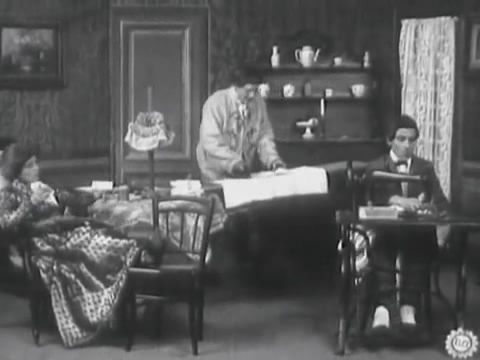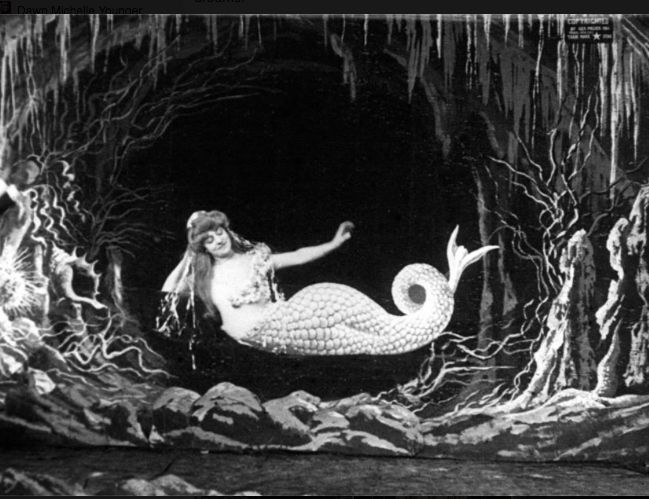101 Imaginary Nights At The Movies
Fifth in a series of 101 imaginary movies, Cinema of Forgotten Dreams is my attempt to dramatize film history by creating and commenting on a repository of imaginative film viewing. From the earliest days of cinema to the era of blockbusters, my century (plus one) of Movies I Made Up will proceed chronologically through an alternate dimension of films. Will it be allowed? Will anyone read? Though I have no answer to either question, I’m doing it anyway: fortunately, there are no rules in the land of dreams.

Still from Alice Guy’s Les Résultats du féminisme (1906)

still from Georges Méliès’s La Sirène (1904)
A JOURNEY INTO THE EMOTIONS
1903, Alice Guy & Georges Méliès
The popular Parisian weekly arts periodical, La Reverie, recorded this open-letter missive from filmmaker Alice Guy, head of production at Gaumont, to fellow filmmaker Georges Méliès, founder and chief director of the Star Film Company, on the second page of their issue dated March 18, 1903:

Alice Guy
[translated] Dear Sir: It is with equal amounts admiration and apprehension that I record a stray observation to my recent viewing, at Café Parisien, of your latest screen fantasy entitled The Mermaid. The vision of your inventor/magician, as he visualizes his art within a light-projected and underwater glass tank, seems an unequivocal metaphor for the medium we have individually chosen to practice; however, that his dream made real should result in self-created love, in the feminine image of a sparingly-clad sea creature, seems curiously uninvolving and emotionally untrue to the story and its characters. [Eds. note: The film referred to and described by Ms. Guy shares a title and premise with a later film, from the following year, also titled The Mermaid.] While one certainly admires the imagination and technique, one further wonders how your second screen self, having called a mere object of affection into uncertain being, might have fared in the next reel, when the creature naturally discovers her own mind and will just as the fruition of her creator’s imaginative efforts crumble to ashes.
Méliès’s response, appearing in the next issue of La Reverie, dated March 23, took note of those objections and offered a challenge of his own:

Georges Méliès
[translated] Madame: Working in a medium closely aligned with the imagination, my own production methods, along with the pace of planning and realization, offers scant opportunity for reflection and self-criticism such as detailed in your intriguing analysis. I admit to these being visualizations of my dreams and fantasies, and their projection will ultimately reflect my own frail and imperfect humanity. Were it otherwise, however, might the artistic clash between two strong wills somehow result in an imaginative accord that would in fact cancel the other’s paucity of vision?
And with the discreet though verbose charm of a more civilized era of communication, a further communique between the respective representatives of the filmmakers, from Georges’ brother Gaston [the elder Méliès who then acted as agent for his brother’s films in New York City] to Gaumont Co. clerk Herbert Blaché [a British-born filmmaker who later married and formed Solax Studios with Alice Guy], arranged for the leading male and female directors in France to collaborate on the financially neutral though artistically fertile ground of Central Paris’s Gymnasium Fantastique. The imposing red-brick, fortress-like structure, with its vast and shadowy, sparsely-appointed theater interior, became an ideal space within which to create the imaginative epic that would first be projected between its red velvet curtains, on May 7, 1903, under the title A Journey Into The Emotions:

[10 film meters] A starry sky superimposed over an ox-eye daisy, combining the respective companies of its creative participants into a single logo, precedes a curtain fall over a petit bourgeois drawing room; its patterned wallpaper incorporating unusual geometric shapes, random squiggles, and scratchy designs.
[20 film meters] A handsome man of sturdy middle age – thoughtfully stroking his curled and waxed mustaches – sits in an overstuffed armchair, pondering a thick ledger spread over his lap. To his right, across the glass surface of a tea-stand, the handsome man’s equally handsome wife – pensively stroking the high-coiffured bun of her bouffant – slinks forward into the plush folds of a diagonal settee, resting her chin over the narrow armrest facing her husband’s armchair. The man briefly returns his wife’s stare – or, more accurately, glare – and, unconcerned, resumes his studies.
[41 film meters] The light dims in the background, leaving the domestic tableaux momentarily in shadowy relief, before brightening to show the patterned wallpaper has been replaced by a cream-tinged screen. Rapidly filling the background with its growing dimensions, the couple slowly turn to find themselves enveloped within the contours of the now empty frame. Standing, the settee and armchair, along with the husband’s bound volume, disappear, and the man and woman are left in the sterile blankness of the stage’s fixed and unyielding proscenium view.
[82 film meters] All at once, the background begins moving, stage right, to reveal visions, memories, and dreamscapes from the couple’s mutual childhood; the forgotten hills of their countryside village passing into the carefree streams and tributaries of their schooldays, through moonlit evenings under the stars and out to a stretching field of sunflowers greeting the dawn. Their shared past gives way to abstract imagery suggesting patterns and shapes converging and diverging with the weight of years, gradually revealed, with the panorama settling to a stop, to be the patterned wallpaper filling the background of their drawing room.
[41 film meters] Back where this intimate drama started, with the husband’s nose in a book and his wife lounging on the settee, the husband glances up across the glass surface and, peering over his pince-nez, an animated balloon escapes his opening lips, “[translated] Shall we change that ugly wallpaper?” The wife, hands resting between her chin and the wood-carved armrest, smiles and the animated balloon escaping her own parting lips responds, “[translated] I think that would be best, dear.” The lights again dimming, this stage of life revolves out of frame and the curly-cueing riot of ill-chosen wallpaper dissolves to the combined logo of the starry sky and ox-bow daisy; this time marked “FIN”.

Guy (right) and future husband Herbert Blaché

Méliès and wife Jeanne d’Alcy (his first film star) in the mid-1930s
Working outside their respectively familiar milieu, the greenhouse-like dream factories of blazing natural light on the outskirts of Paris, Guy and Méliès managed to accomplish the comparatively close-quartered effects described above with practical techniques borrowed from the spectacle theater tradition – including dramatic lighting, revolving stagework, and mobile scenery – alongside cinematic techniques both filmmakers had independently developed – including process photography, realistic acting, and expressive set design – for a seamless melding of stage, screen, and camera. And while it might be tempting to observe that one supplied the fantasy and the other the feelings, Journey undoubtedly derives its unique power from the successful film marriage of one vision with another. It is ultimately impossible to say in viewing this 9 and a half minutes of screen time where illusion ends and reality begins, but each of its 194 meters of projected film nevertheless remains dramatically and emotionally true.


